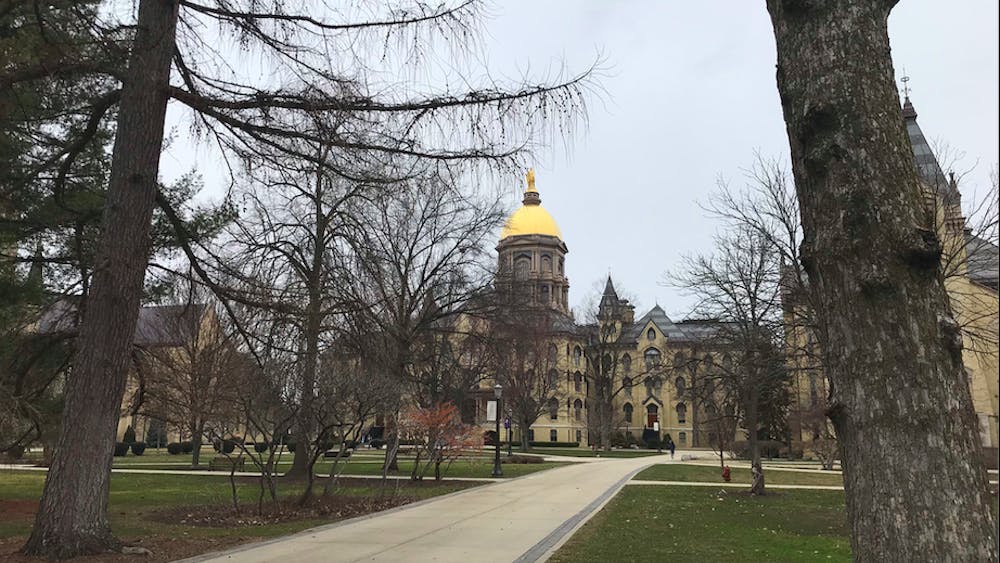
Fr. Bill Beauchamp said the Congregation of Holy Cross has been cutting down invasive Bradford pear trees north of campus.
The Congregation of Holy Cross cut down invasive Bradford pear trees north of campus according to Fr. Bill Beauchamp, a Holy Cross priest.
“We're actually getting rid of trees that are called [Bradford] pears,” Beauchamp said. “[Bradford] pears are an invasive species of trees that have become a problem in this country. They just spread on their own.”
Beauchamp said all the land south of St. Joseph's Lake is owned by the University, while the Congregation owns everything north of the lake.
“Basically, all the land south of the lake is owned by the University and all the land north of the lake — it used to be the old Douglas Road — is owned by the Congregation,” Beauchamp said. “The Congregation owns Corby Hall and the ground but the rest of it is basically all owned by the University”
Cassie Majetic, a biology professor at Saint Mary’s said invasive species often expand in their new environments.
“Invasive species in general are species that are not native to a particular region,” Majetic said. “They are brought into a region. And when they arrive they often face different environmental conditions that allow our populations to grow and expand in unchecked base.”
Majetic said the Bradford pear tree was introduced from Asia in the 1900s to fight a disease happening in the common pear tree.
The seeds of a Callery pear are easily dispersed into open spaces by birds, allowing fast growth, she explained.
“The seeds of the Callery pear are easily dispersed by birds, allowing it to invade open spaces such as pastures, ground, grasslands and open woodlands," Majetic said. "Then it grows really fast and has really rapid growth.”
Thomas Anderson, a professor of Latin American literature at Notre Dame and a bird photographer, said taking out invasive species is crucial.
“Taking out these invasive trees is important too, because they spread and if they don't take them down then 10 years from now those trees are going to just be everywhere,” Anderson said. “Open spaces are also very important.”
The spread of invasive species will choke out the growth of natural tree species, Beauchamp said. In addition to protecting the native vegetation and wildlife, Majetic added that pulling out the invasive species can lead to beautiful replacements.
“There's more of an interest of pulling those invasive species out and replacing them with some really beautiful native species to this region that actually better support the wildlife,” Majetic said. “And so if you can remove those invasives you remove that competition, you can bring in some equally gorgeous things.”
Beauchamp said they will cut down the invasive trees and dig up the roots. He added that they have to treat the land to prevent the trees from coming back.
Beauchamp said the Congregation wants to keep the land as natural as possible.
“That's one of the reasons we got rid of the [Bradford] pears to get it back to its natural state," Beauchamp said. "There's some other trees growing in there that were being choked out by these pears.”
Majetic said the city of South Bend is supportive of efforts to increase tree canopy.
“The city of South Bend is very engaged in tree canopy support in the city,” she said. “They planted a lot of Callery pears back in the 60s, 70s and even into the 80s and 90s. Now all of the projects that they are doing involve replacing or removing trees are using native species.”
Anderson said the area by St. Joseph's Lake where the trees were removed is important to him.
“One of the many reasons IcaresomuchaboutthecampusisbecauseI'mabirdphotographerandI'vebeen doing this several years,” Anderson said. “I've spent hundreds of hours back in that area taking pictures of birds especially in the spring and the fall. And I was just really shocked to see all these trees coming down.”
Anderson hoped all these projects are taking into account the environmental impact.
“IthinkmybiggestmessageisthatI hopethatalloftheseprojectsthatarebeingdoneare takingintoaccounttheimpactthat they are going to haveontheanimalsandthebirdsoncampus because Notre Dame campus is a nature sanctuary,” Anderson said.
The number one concern for Anderson is making sure whatever trees come done are chosen for good reason.
“Around the lakes is a great variety of trees and sometimes when they get old … They have to come down but my number one concern is that they make sure that whatever trees come down are coming down for good reasons,” he said.
Beauchamp said it will take a few years to treat the land before wildflowers will be planted and left to grow in the area.









